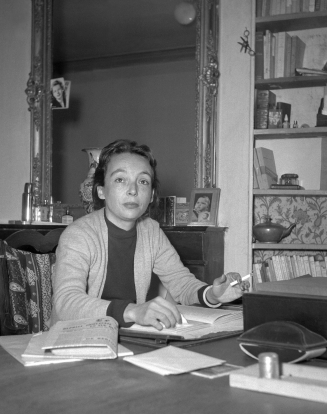
‘In the 1970 first published in English edition of Destroy, She Said Marguerite Duras has added a couple of paragraphs at the back entitled ‘notes for performance’ indicating the novel can be used as a play. In these notes she makes suggestions about characters physical appearances, inflections, movement styles etc. Towards the end she makes this interesting point: “No one actually ‘cries out’, even when the word is used: it indicates an inner reaction only.”
‘This is an excellent summation of Destroy, She Said, a novel rife with pent-up frustrations, and the interpersonal attack human creates will make on another human creature they perceive for whatever reason, may be weaker than themselves. It’s a wholly political novel, written in 1969 under the pro economic modernist and contemporary industrialist presidency of Georges Pompidou. In fact when one of the two main characters describes herself and her two contemporaries as German Jews, she is referring to a famous anti-nationalist student slogan of 1968.
‘However, when Pompidou tried to appropriate the novel as a symbol of the destructiveness of modern youth, he made an error. The ‘Capitalist destruction’ Alissa is bent on is not the destruction of buildings and institutions, but the annihilation of ‘civilized’ egoism. Marguerite Duras herself said “Destroy… annuls the others” meaning that this is the most radically revolutionary of Duras’ novels providing a kind of crescendo for a lifetime of work, in terms of her political points. Destroy She Said may not be the most exquisitely beautiful of her works (there is an ocean of exquisite beauty in Marguerite Duras, so which work can be seen as the apex of all that is far beyond me to judge) but it is the most aggressive and forthright that I have read. The way the three main characters descend upon Elizabeth Alione is ruthless in the unapologetic self-serving nature. Characters are often cries in Duras’ novels, and always haunted by the unsayable, but these three are unencumbered by their own philosophical positions; rather they are inquiring as they conquer.
‘Barbra Bray (translator) writes in the introduction to the English translation, that Duras’ characters have always managed somehow to dissolve barriers between them despite overwhelming gulfs in recognition of person hood. In Destroy, She Said this is no longer a tendency but a fully realized notion. In Destroy, She Said, Alissa, Max Thor and Stein are almost interchangeable. Their relationships and identities are always interchanging, subtly shifting and merging and admit none of the men and women’s usual possessiveness and competition. Even Alissa and her antagonist Elizabeth (or should I say her ‘prey’) can meld into one in certain scenes in the novel.
‘In many ways Elizabeth represents many Duras heroines prior to this novel: middle-aged, bourgeois, elegant, attractive, whose life is all emotion. Through the eyes of the three young people she emerges as weak and in need of conversion, but in typical Duras style, we see her differently to those around her. To quote Bray again, “The character, in spite of having now been marked down for demolition, is much the same; it is the author who has moved on.”
‘It is this inter subjectivity in the novel, especially revealed through the use of ‘he’ and ‘she’, that keeps the book far from any form of realism. There is no need within the novel to puzzle out the relationship between Alissa, Max Thor and Stein despite their constant interwoven narrative, declarations of love, and mutual intentions. Prior to this, Duras’ concepts of love were more or less conventional, always straining toward an impossible fulfillment. In Destroy, She Said, the battles between men and women are abandoned. Stein and Max Thor both love Alissa without jealousy and Stein counsels Alissa in not reacting to Maz Thors feelings for Elizabeth Alione. This counseling is a direct reference to Bakunin and the anarchist notions of “not suffering”. “The psychological implications of all this are not even glanced at. They are not the point. The book presents a pattern rather than relates a narrative,” states Bray in the introduction.
‘It is Duras’ habit of seeing what she writes and writing what she sees that moves the structure to its natural powerful reduction. The novel Destroy She Said owes as much to the image as to the word. When the book is made into the film, the images becomes beautifully dependent on the word. The result is something condensed as always with Duras, physical ambiance kept to a minimum. None of the other hotel gusts are ever seen. The Tennis is only ever heard. In the dialogue there is no analysis and no suppositions about what anyone things or feels. Characters are oblique as necessary to give meaning, not representations of real people. The result is a radical novel, as difficult to grasp as it is enticing to read. One gets the feeling of holding a subversive text, though the revolution is never within one’s grasp. In this way, Georges Pompidou was accurate in that it was a novel with timely tale to tell, but perhaps not as neatly prescribed as he hoped. Perhaps, also far more radical than he could be comfortable with.’ — Lisa Thatcher
___
Further
Marguerite Duras Site
‘Destroy, She Said’ @ goodreads
Discussion: May selection: Marguerite Duras’ Destroy, She Said
The Novelist as Filmmaker: Marguerite Duras’ “Destroy, She Said”
Chamber Utopia – A Commune Banished In Advance – A Different Humanity (Real Humanism vs. Vanity)
In a play-like novel which was later the same year turned into a haunting film
Erosion by Desire: Marguerite Duras’ Self-Adaptations
A Review of She Said Destroy, by Nadia Bulkin
Awe, reverence, respect, self-respect, shamefastness, sense of honor, sobriety, moderation, regard for others, regard for the helpless, compassion, shyness, coyness, scandal, dignity, majesty, Majesty.
OUT OF TIME
Buy ‘Destroy, She Said’
___
The film
‘Translating an enormously dense short novel to the screen is no easy feat, even if it’s your own novel. Especially when the very architecture of text on the page and the limitations of the written word are foundational to the story’s ultimate purpose. In the novel you get a sense of some metaphysical fusion of the three lead characters during their interrogation of Elisabeth, which is super difficult to replicate in film. The subtle influence of the cinematic language in sequences that hint at cuts and a flow of editing are made overt on the screen. But even this is something special. To see the architecture of word structure replaced with the architecture of characters within a hotel. Leaning against walls, caught between mirrors and perspective, light and shadow. The camera is ever shifting its perspective without losing its targets. What it loses by including visual reference it gains from knowledge of cinema’s time capturing abilities. The use of long static takes is beautiful. The framing is beautiful. The mirror shot!! The flow of their interrogations are uncomfortably clear. The precision of their words maybe seem more obvious. The card game scene is frighteningas hell. I don’t think it exceeded the magnificent (and perfect) text, but what Duras created on film is still mesmerizing.’ — Jacob
Excerpt
Excerpt
the entirety (French, no subtitles)
____
Extra
Marguerite Duras à propos de “Détruire dit-elle” (Destroy, She Said)
____
Manuscript page
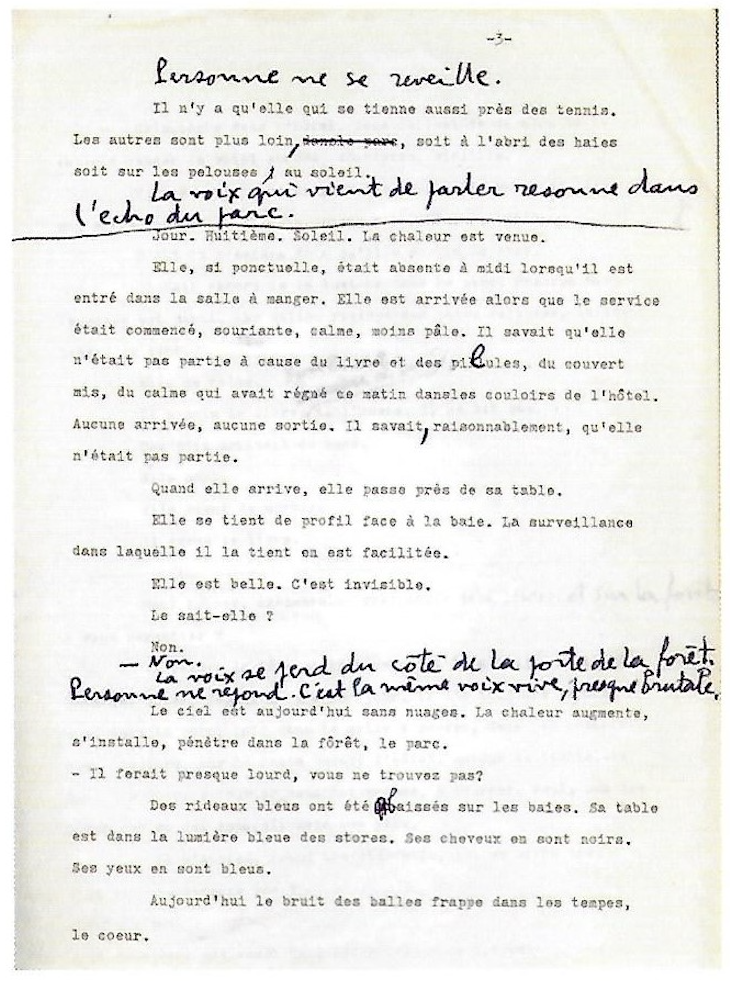
____
Interview
from Seven Stories
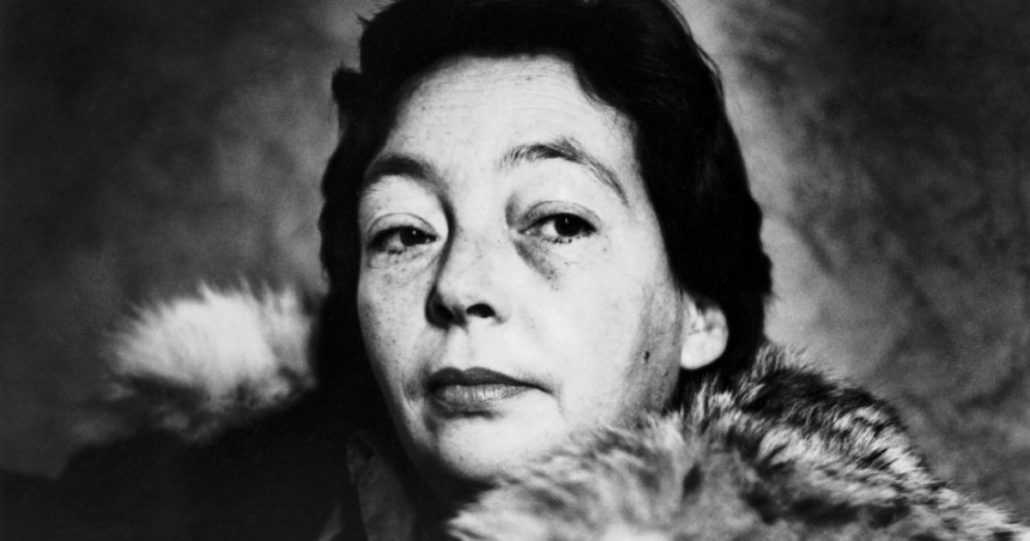
Question: It seems you want more and more to give successive forms to each of the things—let’s not use the word “stories”—that you write… for instance, The Square, which had several versions, or La Musica, which also had several forms, or L’Amante anglaise. This corresponds to…
Answer: To the desire that I always have to tear what has gone before to pieces. Destroy, She Said is a fragmented book from the novelistic point of view. I don’t think there are any sentences in it. And there are directions that are mindful of screen plays: “sunshine,” “seventh day,” “heat,” “intense light,” “twilight”—do you see what I mean? I would like the material that is to be read to be as free as possible of style. I can’t read novels at all any more. Because of the sentences.
Q: When you wrote these stage directions, was the idea of a film lingering in your mind? Or was it simply because you could only write in this form?
A: I had no idea of a film, but I did have the idea of a book … of a book that could be either read or acted or filmed or, I always add, simply thrown away.
Q: In any case, you had theater in mind somehow…
A: Yes, yes, Claude Régy was to stage it, but I made the film first, I couldn’t help it … I believe it necessary to create things that are more and more timesaving, that can be read quickly, that give the reader a more important role. There are ten ways to read Destroy, She Said; that’s what I wanted. And ten ways to see it, too. But, you know, it’s a book I hardly know at all. I know the film better than the book; I wrote the book very quickly. There was a good scenario, called “The Chaise Longue,” which we tried to film; but it came out of a certain kind of psychology, maybe a searching one, but psychology nonetheless; and Stein wasn’t in it …
Q: Did the scenario come before the writing of the book?
A: “The Chaise Longue,” yes. There were only three characters. Still, as a story it was obviously classical. When I found Stein, the scenario wasn’t any good at all any more, and we threw the whole thing out that same day.
Q: I was struck by an interesting contrast between film and book. The directions for the characters are very brief in the book, but a number of acts and gestures in the book are omitted from the film. In the end, the film is a kind of mechanical process that is exactly the opposite of the one whereby a bad filmmaker who adapts a book keeps the events, the facts, the physical acts, and leaves out everything which would seem, on the contrary, to belong to the writing itself. And here one has the impression that you took out everything that would seem to stem directly from “cinema,” and that you kept what would seem to belong to the realm of literature.
A: That is correct; I had a feeling that this was so. Are you thinking of any special gesture?
Q: I’m thinking of several: the moment, for example, when Stein strokes Alissa’s legs. The only part of this passage that is left in the film is the conversation.
A: It so happens that during rehearsals I realized that it was impossible, because of Michel Lonsdale, who is gigantic. He was too important, if you like, sitting there at Alissa’s feet, close to her legs. I had to keep him away from the other two, so that they wouldn’t be completely overwhelmed. So it was really for practical reasons that I came to omit this gesture. I worked on the possibility of keeping this gesture for a long time. I wasn’t able to do so, and I’m sorry.
Q: But there were rehearsals that took place before…
A: They were at my house. For a month and a half.
Q: Did you rehearse everything before shooting?
A: Yes.
Q: But wasn’t it also true that Stein at that point was too much on the same plane as the other characters? Or was it just this one gesture that was impossible?
A: Oh, it’s very hard to say why it was impossible. It wasn’t possible; it obviously wasn’t possible. Or else it would have been necessary for him not to say anything. It was a choice of either the gesture or the dialogue. I think it was because of Michel’s size. What did you think of him in the film?
Q: He is magnificent. He is always a very great actor, but here he is even more of one; it’s really great to see him finally being used…
A: This was the first time. The first time he has ever been used like that…
Q: And did the other actors come to mind immediately? This is one of the things that make the film really impressive: the choice of the five actors, the way they harmonize. And I personally was flabbergasted when Gélin was used.
A: I thought of Gélin almost immediately. The hardest one to find was Max Thor: Garcin.
Q: Destroy, She Said is made up structurally of people watching each other at different levels. For example, someone is watching the tennis court and is watched by someone else, who in turn is observed by a third party, and the narrator, or whatever plays a narrative role, more or less takes up these stories and sees what these watching eyes see…
A: You see a narrator? … It is the camera.
Q: Does it exist as a watching eye?
A: Yes, in the film.
Q: Perhaps the expression “watching eye” is not the right one. Let’s say, then, a last determining factor, a last court of appeal.
A: As if someone wanted to tie the whole thing together?
Q: No, it is not something static, but a watching function, so to speak.
A: But this watching function can also be called identification with the character. Do you agree with that? With the sacred law that Sartre laid down in an article answering Mauriac, I believe, about twenty years ago, in which he said that one could identify only with one person. To reach the other characters it is necessary, therefore, to do so through the character with which one identifies: if there are A, B, C—A being the spectator and the character with whom one identifies, one must go through him in order to reach B and C.
Q: Yes. Sartre accused Mauriac of taking himself for God and dominating all the characters.
A: That’s right. But this is a law that has applied to spectacles for centuries now. And to novels, too. I attempted to break this law; I don’t know whether I succeeded. There is no primacy of one character over another in Destroy, She Said. There is a gliding from one character to another. Why? I think it’s because they’re all the same. These three characters, I believe, are completely interchangeable. So I went about things in such a way that the camera is never conclusive with regards to the way one of them acts or the words that another speaks. What one of the men says could also be said by the other. What the other says, the third person, Alissa, might say as well. The men are slightly different from Alissa, it is true, since she doesn’t speak of the men, whereas the men speak of her. She never judges. She never goes on to think in generalities.
Q: I find the film quite a bit more complex than the book. In the book one has somewhat the impression which one loses in the film—that Stein is something of a dispenser of wisdom.
A: He says one thing about there being no need to suffer any more that illustrates what you are saying: “It’s not worth it to suffer, Alissa, not ever again, not anybody, it’s not worth it.” This is more or less what Bakunin said: “The people are ready… They are beginning to understand that they are in no way obliged to suffer”… For Philippe Boyer, in La Quinzaine littéraire, Stein is the one who “speaks the desire of Thor,” and who is going to allow him to go beyond modesty, the rules of the outside world, the world of order. For him Alissa is “the one who destroys and who brings on madness in all its power.” Many people have said that the characters in Destroy, She Said are mutants. That Stein, especially, is a mutant. I more or less agree.
Q: What struck me most was a sort of passage from numbness, in the full sense of the word…
A: A hippie numbness, almost…
Q: …to a waking state.
A: In Stein? Or in everybody?
Q: In all the characters. It is a film on a state of drowsiness, with escapes, with arousals from this state of numbness…
A: That pleases me a great deal. I was very frightened while I was writing it. I was fear itself.
Q: The word “destroy” comes much later in the film than in the book. And the film has: “She said: ‘Destroy.’”
A: This caused lots of misunderstandings. Because, when Thor and Alissa said it, when it was said as one person to another, between just the two of them, people thought that it was a reference to an erotic intimacy that did not concern the others. In the film the word is said in public. I take it to be a slogan.
Q: In the film Alissa acts by coming closer, by making contacts, even at a distance, by…
A: Tropisms… Nobody can bear her except Stein. She is not made for living and yet she is alive.
Q: She is discomfort, in the strongest sense…
A: Yes. She is anxiety itself. Live anxiety. Live innocence with no recourse to speech. I can’t talk about a character; I tell myself that the actors are going to read the thing, and say: “See, she prefers Alissa to Stein …” No, Stein is the character most like a brother to me… Would you like us to talk about conditions while shooting? The film was shot in fourteen days, after a month and a half of rehearsals, and it cost $44,000. I don’t know whether that will interest your readers.
Q: The $44,000 covered everything?
A: I don’t know. I couldn’t have done it without those rehearsals. But don’t get the idea that sequence-shots are shots that don’t cost very much. I’m afraid that that’s what people will say.
Q: What’s economical, often, is to cut.
A: Not necessarily. No. Just imagine: I have a hundred and thirty-six shots, but a good sixty of them weren’t used. The closeups of the meal. But I realized after shooting, during the rough cut, that what was interesting was the impact, for instance, during the card game, of the other characters’ words on Bernard Alione. It wasn’t the others saying “we’re German Jews,” it was Bernard Alione reacting to this. Or rather having it thrown at him. Then we cut down drastically on the number of closeups in general. But in fourteen days… Just imagine: we sometimes shot closeups one after the other, without even numbering them—if you can imagine that. It could have been dangerous. But it didn’t matter. One must let oneself go.
Q: What do you mean “let oneself go”?
A: Oh, I let myself drift along. Because I had used a certain emptiness in me as a starting point of the book. I can’t justify that now. After the fact. There are things that are very obscure which aren’t clear to me at all, even now, in the film. But I want to leave it like that. It doesn’t interest me to clear this up. For example, the direction all through the scene of Alissa arriving. The whole symbolism, when she says: “Where is the forest? Is it dangerous?” and then Thor says to her: “How do you know?” and she looks at him and says: “I’m looking at it, I see it…” Afterwards, a long time afterwards, I was able to justify this to myself, but at the moment it was completely instinctive. The forest at that moment was a danger that Thor had incurred. For he was attracted by Elisabeth Alione. And Alissa’s attitude was already a reassurance: “Don’t be afraid,” her husband said reassuringly. And I became aware of this long after I had directed the scene. When I saw the film, I said: “Well, that was exactly right.”
Q: Where does the shot with the words “I didn’t know that Alissa was mad” come in exactly?
A: She leaves the table. There’s a worm’s-eye view of her. And the voice of Stein offscreen saying: “You didn’t tell me that Alissa was mad.” Then Stein is seen, after he has spoken; then Thor says: “I didn’t know.” And after Thor, Stein says offscreen: “The woman I looked for for so long is Alissa Thor.” This is the only time that Alissa is called by her married name, to clearly indicate that Stein is in no way bothered by the fact that Alissa is married… Did you think that the two men were her lovers?
Q: It’s a question that never occurred to me.
A: I don’t know myself…
Q: The hair scene intrigued me…
A: It’s very obscure to me. She cuts her hair… it’s a bizarre gesture. This is one of the most obscure points, and I can’t describe it. I know that it is sacrificial… Were you afraid when you saw Destroy, She Said?
Q: Yes. Fear, as a matter of fact, that the film would stop being uncomfortable.
A: I’ve been told that it’s a frightening film. It frightens me … But it represents a break with everything that I’ve written for films: the couple… It doesn’t interest me any more at all now to do what I’ve already done before. I’d like to make another film on a text that I’m writing. It’s called: “Gringo’s Someone Who Talks.”
Q: Will it be written for the screen?
A: No. Another one of those famous hybrid texts… And it would be a little like Destroy, She Said as well, that is to say, a sort of superexposition of certain things—and the intrusion of the unreal, but not a voluntary one. That is to say that when it happens I leave it in. I don’t try to pass it off as realism.
Q: I wouldn’t use the word “unreal.”
A: I nonetheless believe that that word isn’t far off. But when I say the word “superexposition,” does it mean anything to you? And if I use the word “unreality,” you don’t see. How about if I use the word “surreality”?
Q: Yes, I’d understand that better, except that “surrealism” has the same connotations.
A: Hyper-reality. Yes. But where are we? This film… is not psychological in any way. We’re not in the realm of psychology.
Q: We’re, rather, in the realm of the tactile.
A: Yes, that suits me fine… That cuts me off from everything else in a strange sort of way… But as for Destroy, She Said I was really quite comfortable. Even though I was afraid. And at the same time, completely free. But frightened to death of being free…
___
Book
 Marguerite Duras Destroy, She Said
Marguerite Duras Destroy, She Said
Grove Press
‘In this classic novel by the best-selling author of The Lover, erotic intrigue masks a chillingly deceptive form of madness. Elisabeth Alione is convalescing in a hotel in rural France when she meets two men and another woman. The sophisticated dalliance among the four serves to obscure an underlying violence, which, when the curtain of civilization is drawn aside, reveals in her fellow guests a very contemporary, perhaps even new, form of insanity.
‘Like many of Duras’s novels, Destroy, She Said owes much to cinema, displaying a skillful interplay of dialogue and description. There are recurring moods and motifs from the Duras repertoire: eroticism, lassitude, stifled desire, a beautiful woman, a mysterious forest, a desolate provincial hotel.
‘Included in this volume is an in-depth interview with Duras by Jacques Rivette and Jean Narboni.’ — Grove Press
______
Excerpt

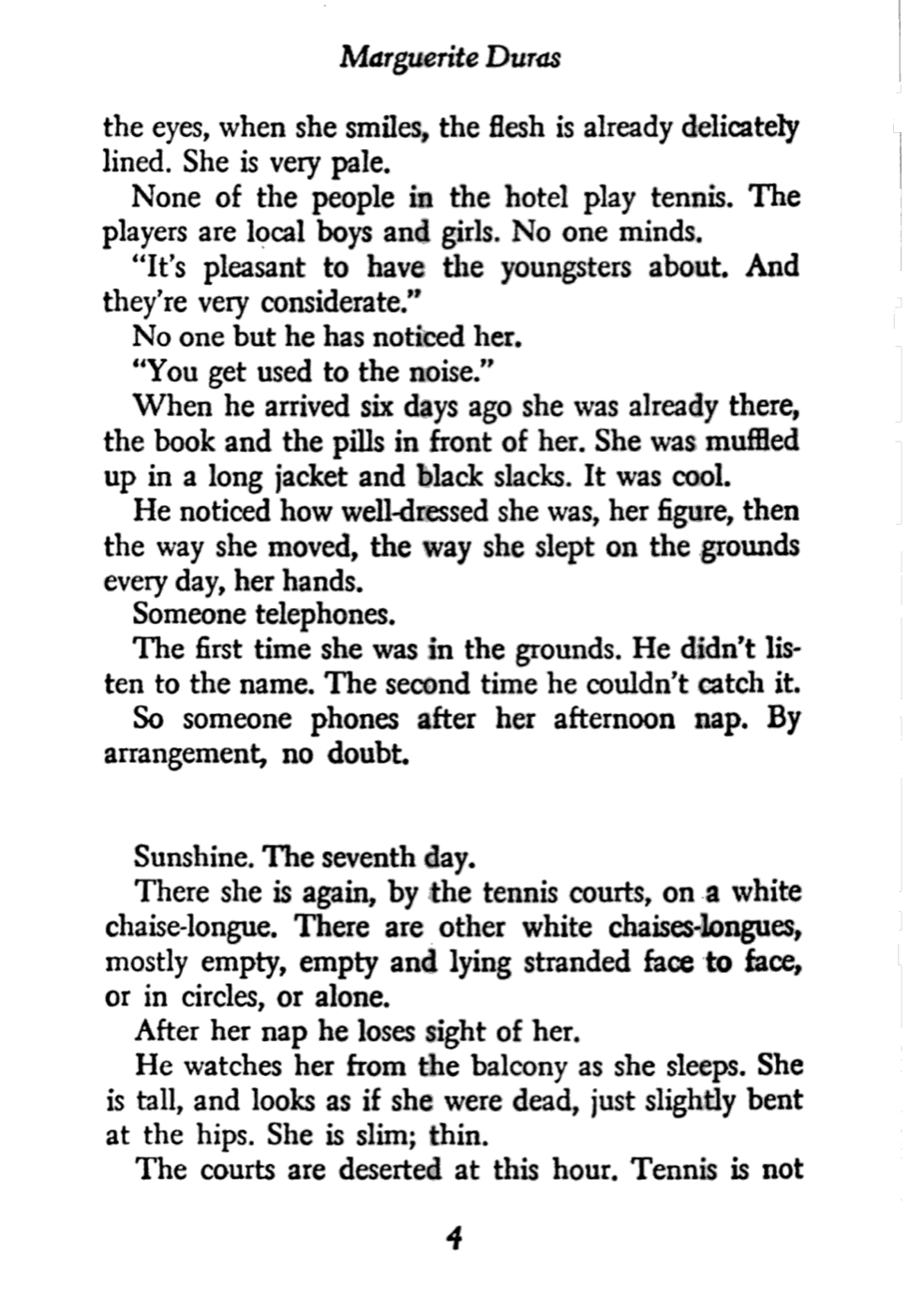

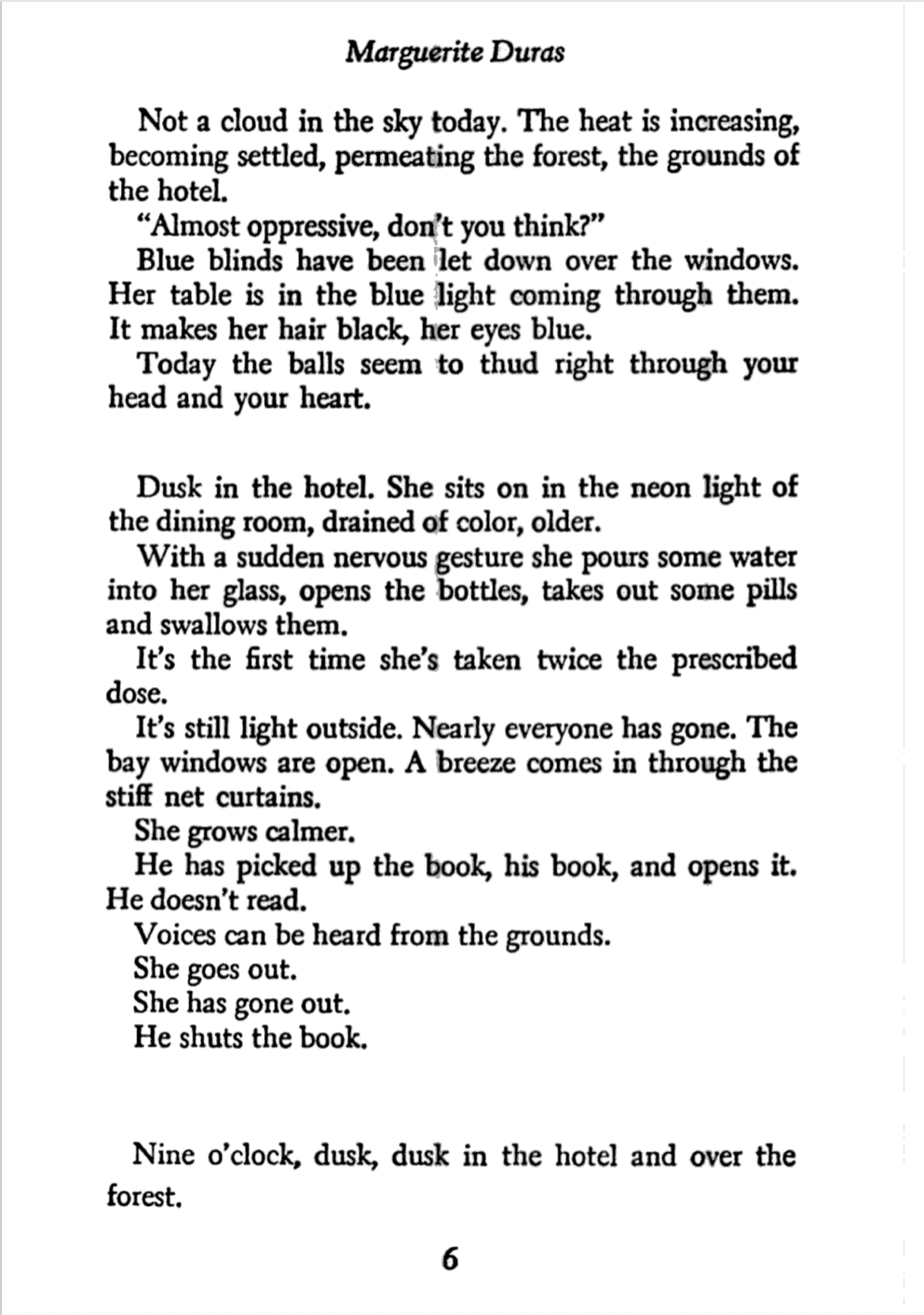
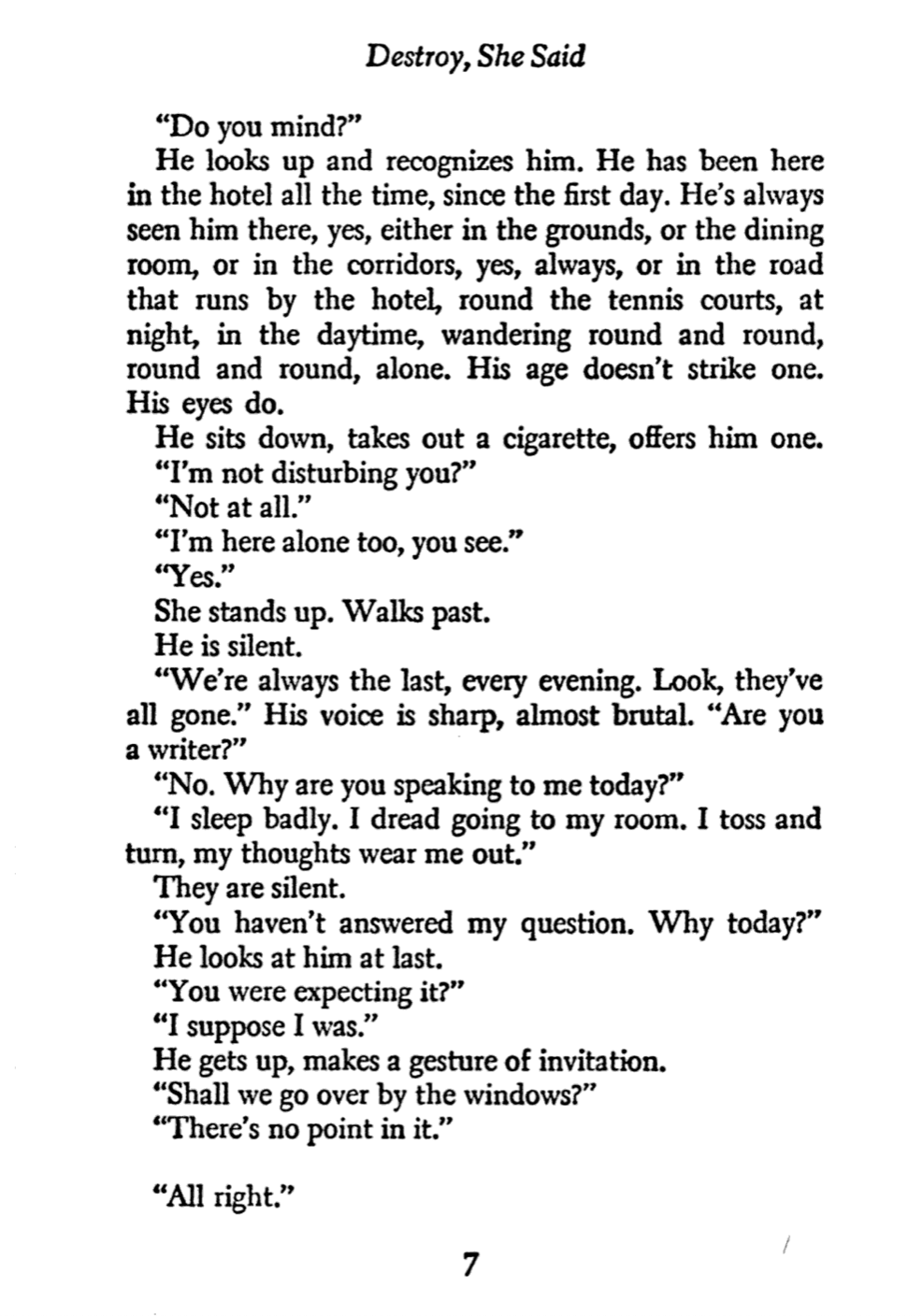
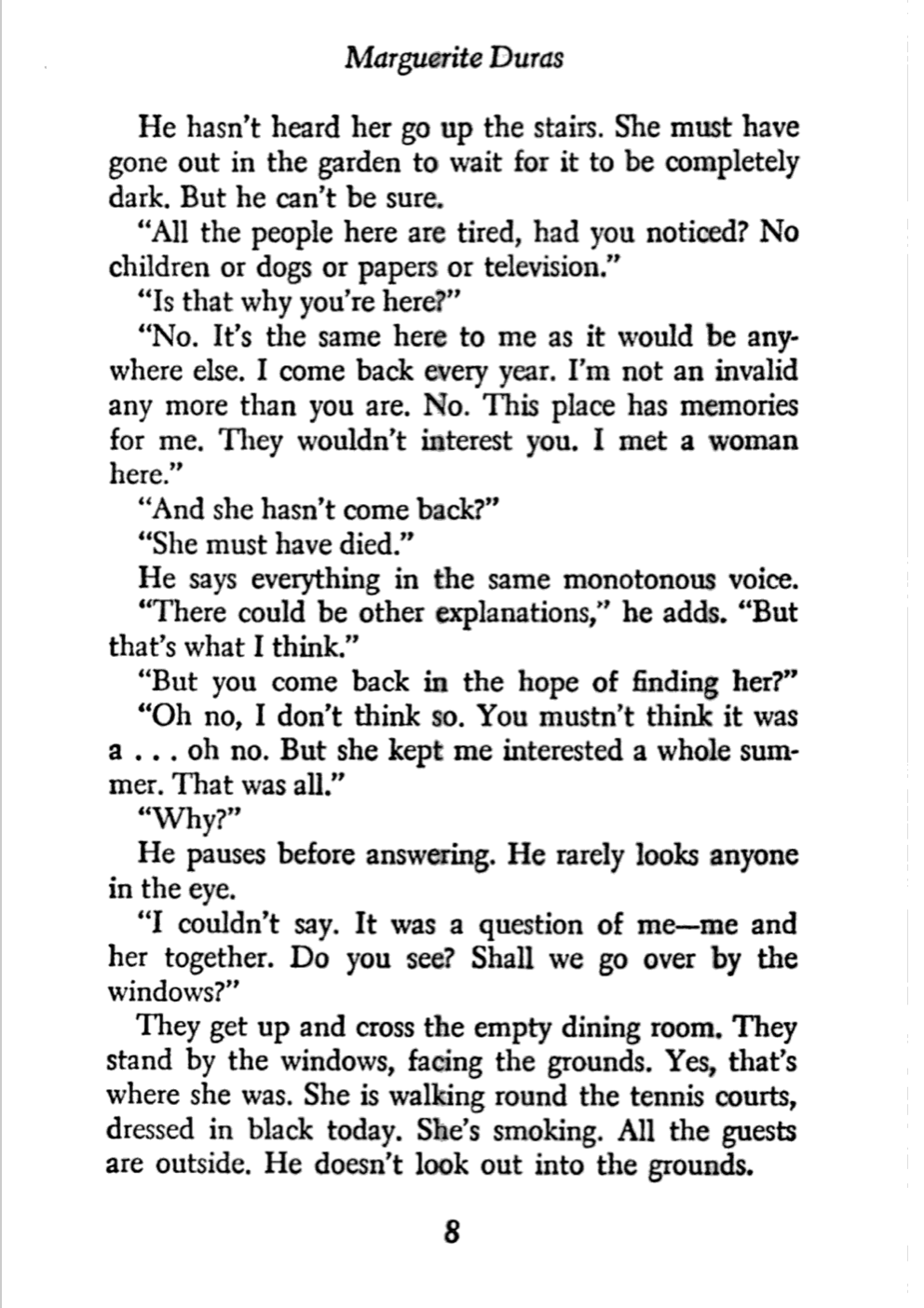
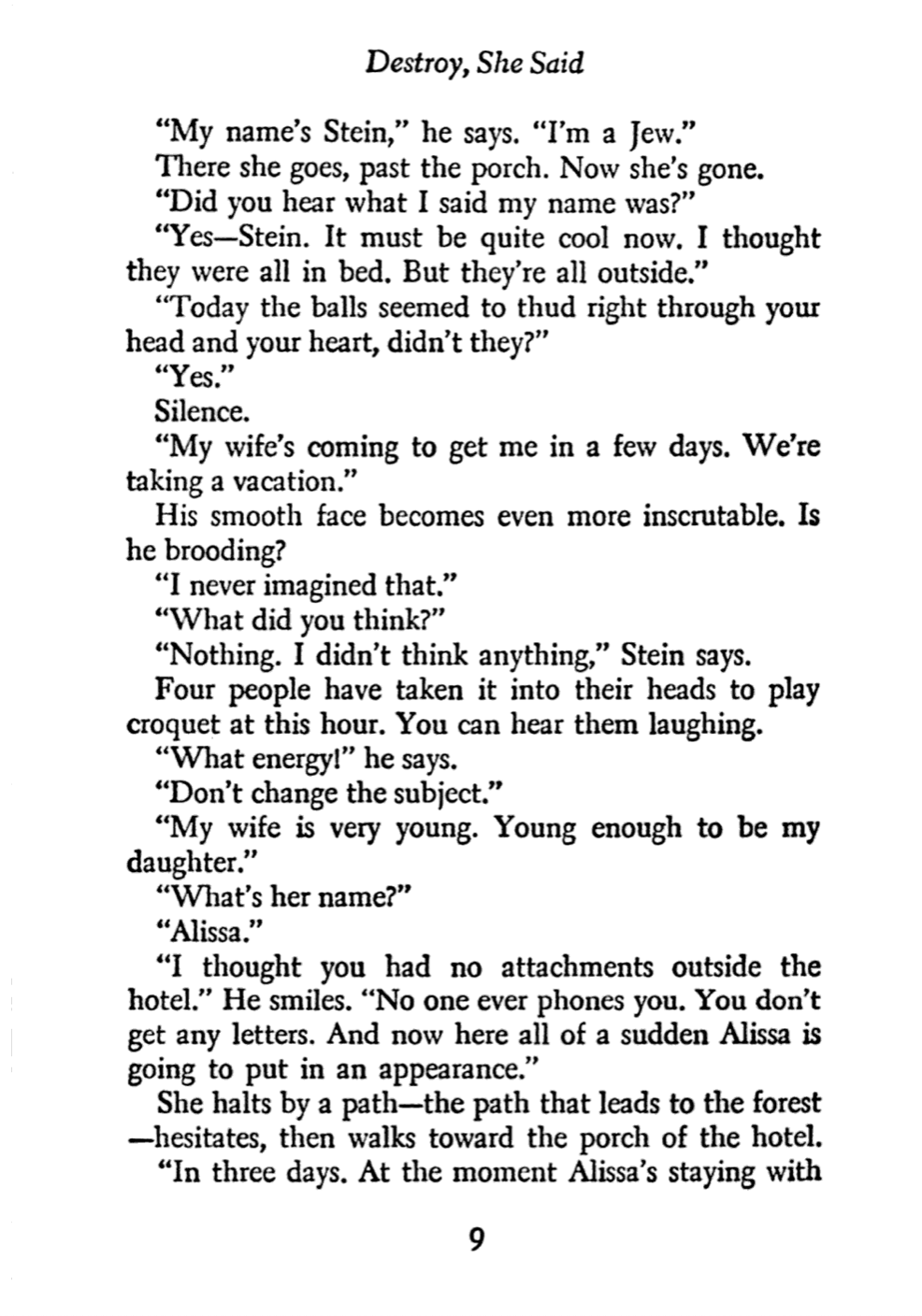
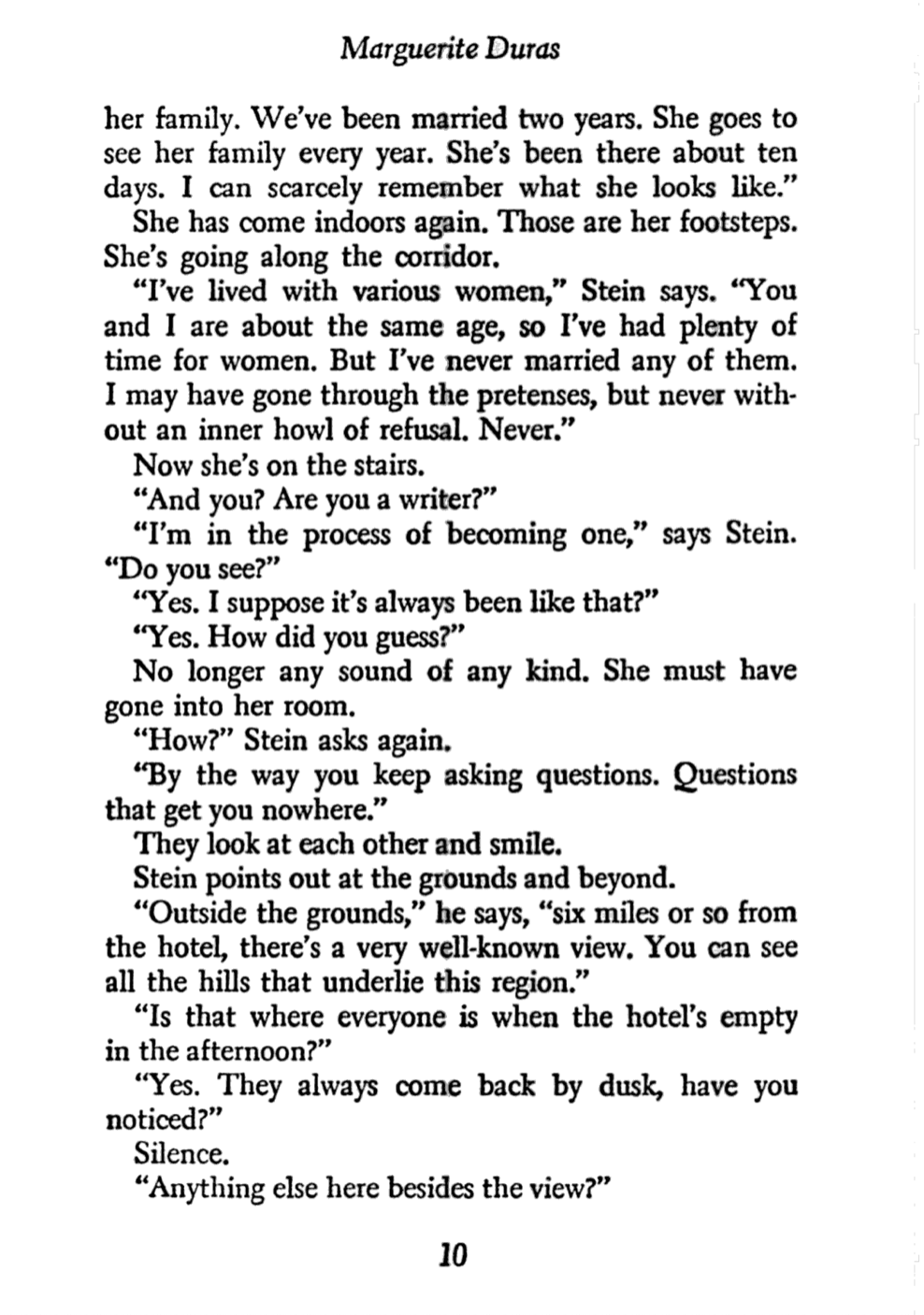
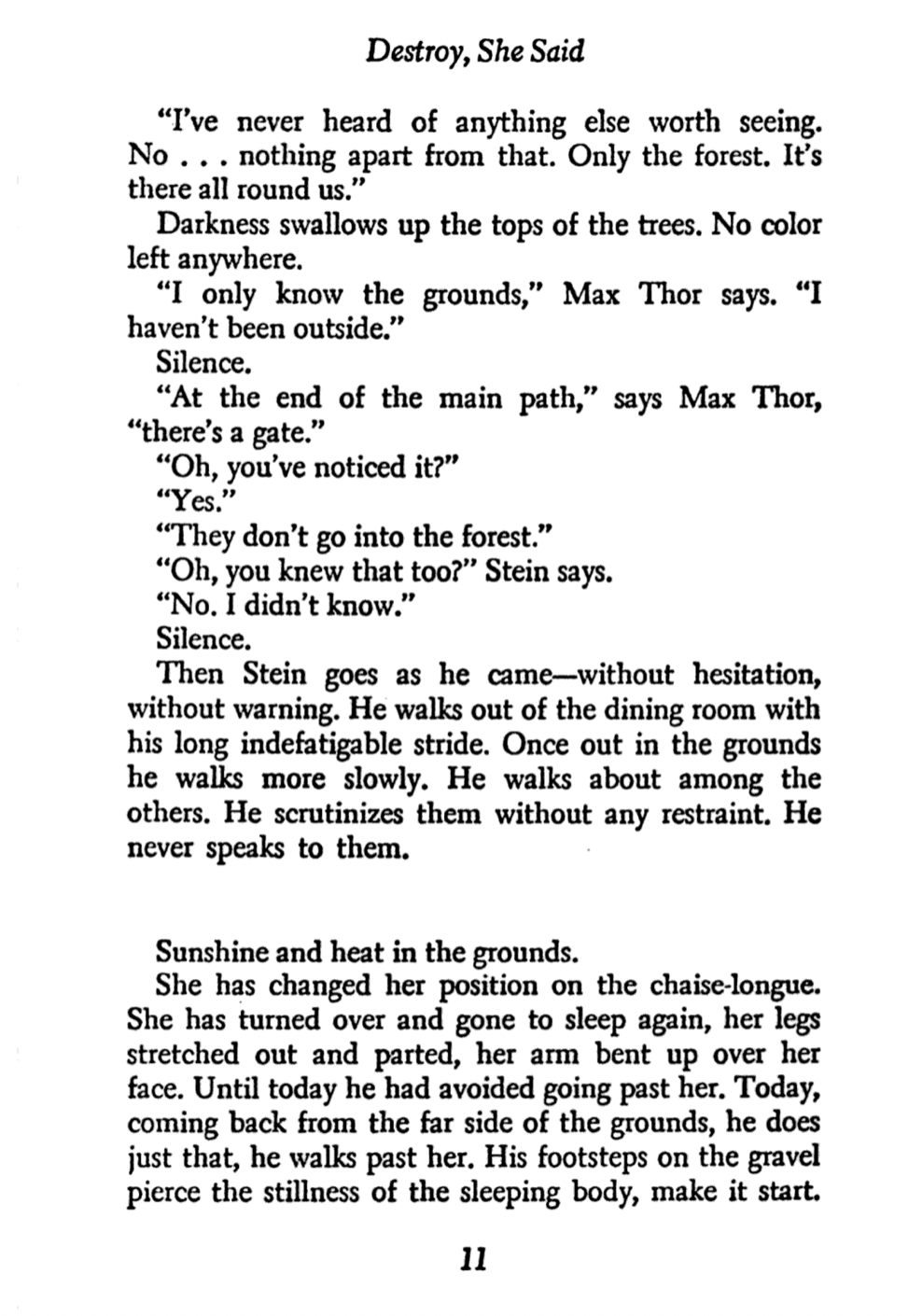
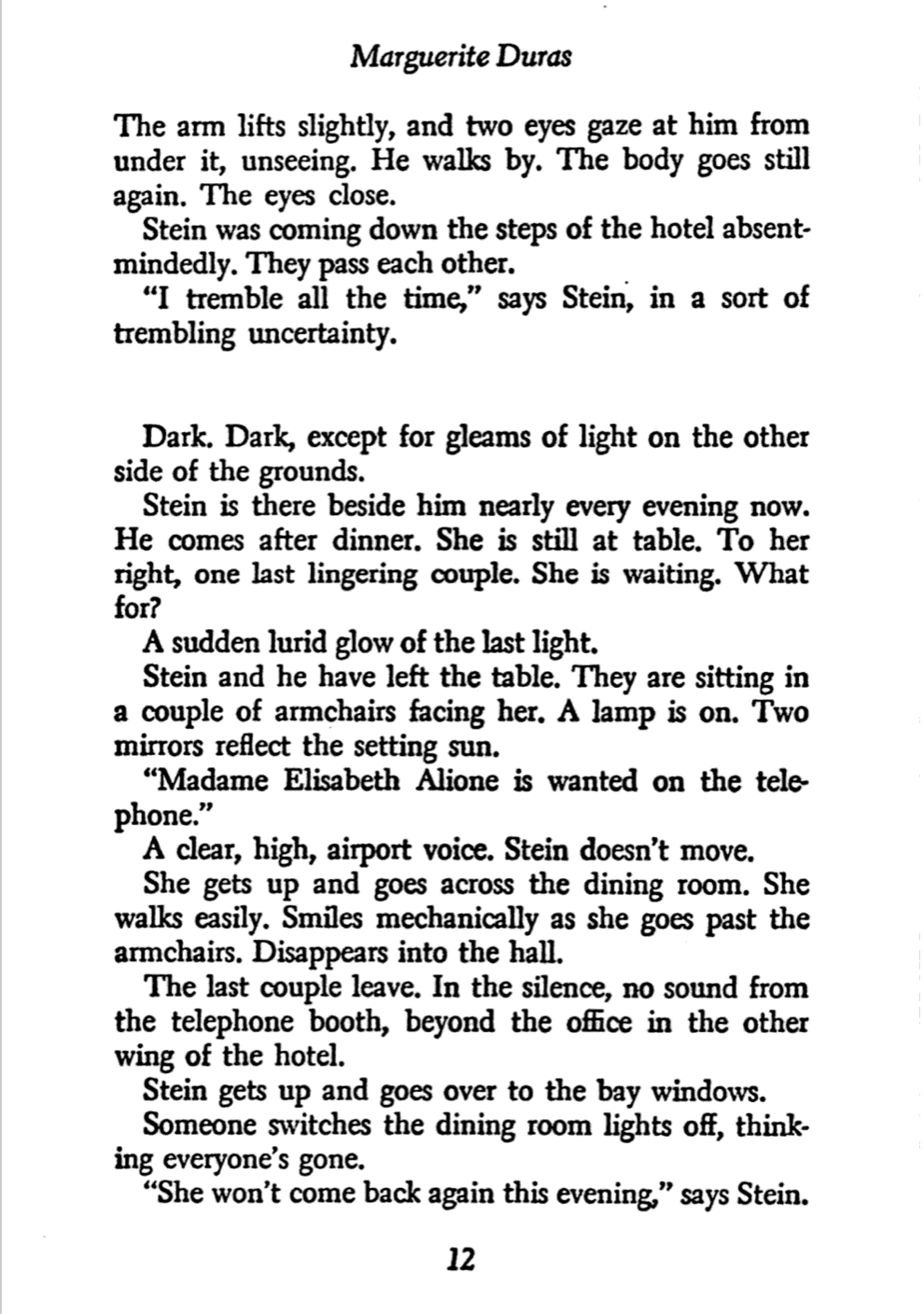
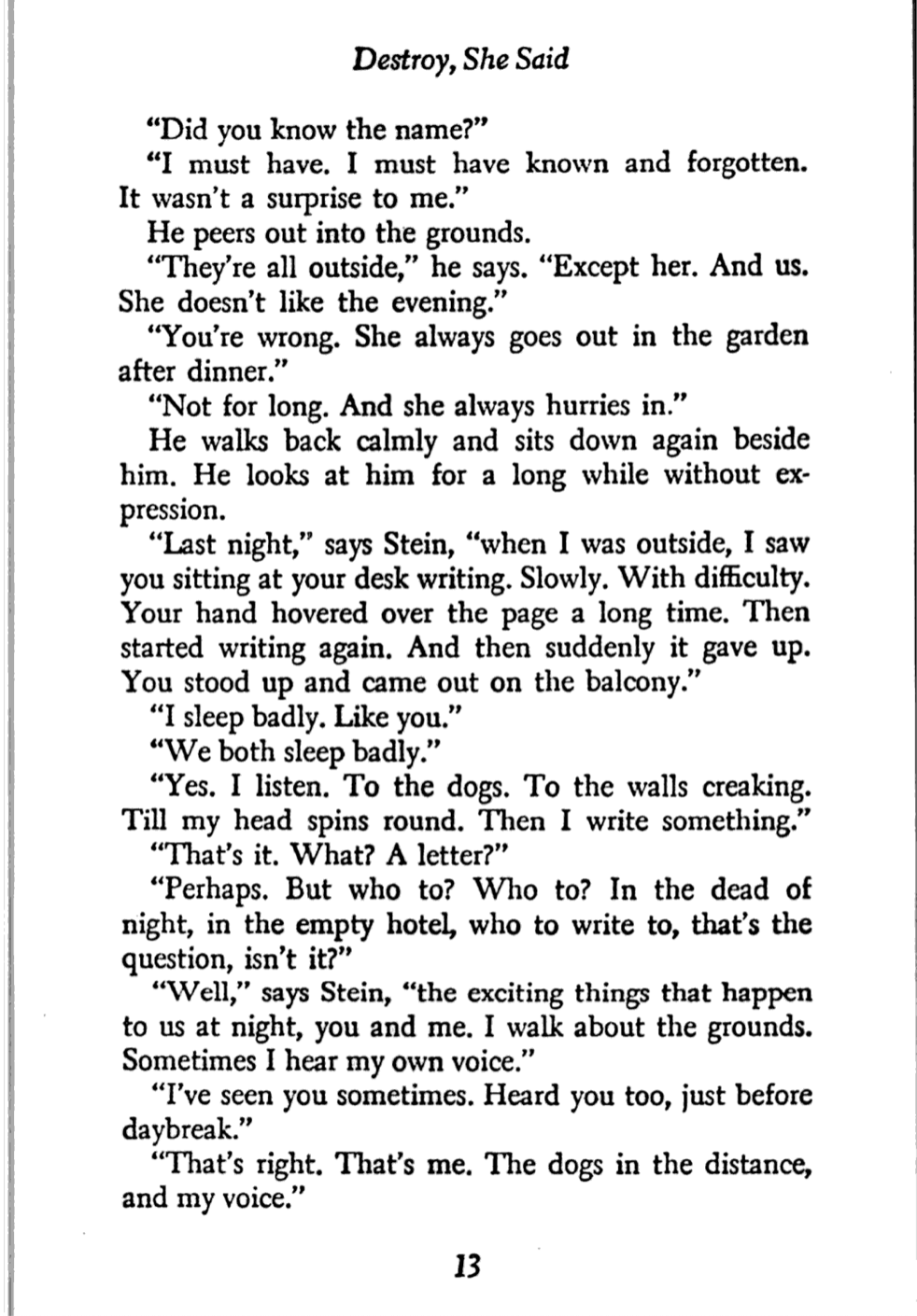
*
p.s. Hey. ** David Ehrenstein, The thanks are all mine, sir! I plan to see the new Scorcese by all means necessary, yes. Glad to read your big thumbs up re: it. ** KeatonKeatonon, Hi. Like I wrote on the post, they’re the Rembrandts of that stuff, I think. Thanks about ‘Gone’, bud. Ah, youth. I’ll try to hunt ‘The Death of Dick Long’, totally news to me. LA is where Halloween shoots its load. ** Steve Erickson, Morning. Everyone, Mr. Erickson says … ‘Here’s my interview with Bassam Tariq. His 22-minute film GHOSTS OF SUGAR LAND started streaming on Netflix yesterday.’ ** _Black_Acrylic, Hey, Ben. ‘The Idols’ is nuts! And, duh, big agreement with you about Clementi. ** John Fram, Hi. I’ll do my best, you bet. Thanks for the luck about the publishing part. Yeah, no fun whatsoever, and less fun even than writing the thing, ha ha, and … time, hopefully not too much, will tell. Gulp. ** Shane Christmass, Hi, Shane. Weird, I was in a mood and watched a video of ‘See What Condition …’ just the other day, and also his/their equally, differently weird same period hit ‘Ruby, Don’t Take Your Love to Town’. Fiji? Seriously? Is that near you? (My geography is spotty). No, I don’t rate Brion Gysin as a writer or thinker at all. Fighting words with some people, I know, but there you go. I like his paintings. ** Right. I’m spotlighting a great novel by Marguerite Duras today if you know it or don’t. Hope you enjoy. I’ll be back once more tomorrow with my p.s. in tow before the blog goes into reruns for the remainder of the Halloween season, so see you then.




 Now available in North America
Now available in North America 
I feel like I see ’68 in some places in Paris. It is almost as if Paris has learned to stir. I see it in the grafitti and naivety of spirit. A funny city, I got accosted violently twice when I wore my hair blond. Sartre is a chef of eggs and Foucault a bad architect. Funny to think my hippie friends run the world now. Just found out my psychiatrist died just after my last treatment. Too bad. Gysin was interesting in an intelligent and artsy way. Interesting for a painter. His Dream Machine is great for creativity. Found a copy of his To Master A Long Goodnight first year of university. Just saw a coffin that simulates being carried and buried when you lay in it. Halloween is turnting up. Got haunted to the point of screaming in my sleep last night. Safe travels. Might you rot your skulls out.
“Destroy She Said” is a marvelous piece of writing and filmmaking by Duras. She has her voice, as always but she doesn’t really find her style until “India Song” in which the soundtrack dominates the image and there is no conventional “acting” as such. Her remarks about Lonsdale are quite telling in that she cast him as Le Vice-Consul de France a Lahore in “India Song” wherein his anguished cry of “ANNA MARAI GUARD !” contrasts with his hulking appearance — wandering through the rooms of the mansion (which is actually in Paris) where the “story” (such as it is) is supposedly set.
This reminds me that I really need to read more Duras one day… believe I’ve only read like 2 of her books or something like that.
Today I released a new Sypha Nadon album, HIRAETH. Like last year’s PLEASANT SONGS it’s all-MIDI, but no vocal tracks this time, just instrumentals. It’s actually the label’s 50th release (yes, we finally hit the big 50, ha ha). Anyway, it can be listened to/downloaded for free here:
https://archive.org/details/MZR050
I really love The Malady of Death so I should get on board with more Duras, she is after all queen of the novella form.
Tomorrow I will finally collect the folded up, stapled-together finished article that is The Call Issue #3. The plan is to spread the word via social media midweek before its big DC’s unveiling next weekend. A long time coming but it’s nearly here, hallelujah!
Dennis! I love Duras. I’m so excited for the new book Dorothy Project put out. I hadn’t read this one, but I’ve had it for a while. Seeing the post I went and read the first 50 pages. I’ll finish it after this, but yeah it’s great. I love the use of layout when Stein and Thor are spying on the women. Very subtle and effective.
I assume you’re a fan of Jonas Mekas, but have you read his poems? I just ordered a new collection that I guess was put out last year. His films are crucial for me. I’m sure his writing will deliver a similar punch.
Exciting stuff about the new film meetings. How they go?
Just submitting submitting submitting. You know how it goes. I made a huge change to the manu that I think was the extra kick it needed, so that feels good.
What’s the rest of your week looking like?
Hey Dennis by the way, you ever do a Zoë Lund post? I just re-watched Bad Lieutenant and can’t stop thinking about her. Apparently she wrote the part where Keitel’s smacked out and she goes in about vampires having it easy: https://zoelund.com/docs/VampireSpeech.html. Great piece of writing. Wish I wrote something like that. Just curious.
Dennis, Thanks.
Man, I’ve been out of it lately. No, not jet lag. Just been staying up late watching the Nationals make it to the World Series and then trying to get that sleep back the next nights. Not fun. Well, watching them win is fun.
Yeah, Paul Knowles is an old friend of Rigby’s. He’s a friend of yours on FB, but you’ve never met him in real life, I’m sure. He and Rigby met 22 years ago. He’s from the north of England and has been in London for a couple decades. Works at a department store by day…and makes noise music by night. Really sweet guy. The kids loved him.
Here’s something that was kind of interesting re: CROWD. We watched Noe’s CLIMAX earlier in the week, and we all found similarities/parallels between that and CROWD. Do you see any?
I mentioned the ghosting guy to a co-worker yesterday and she goes, “Law and Order: SVU! He’s gonna download malware onto your phone!” She was serious. But the dude did give me his real name and number. Can’t imagine he’d be that brazen. 😮
Oh, and finished the first draft of my novel over the weekend. Now to go back and work on it some more. Mainly line edits. There are a few things I want to shore up. There will be some rewriting of some smaller sections/paragraphs, I’m sure. But glad to get that first draft finished. Now the fun part.
Oh, and saw Mr. Fram on here. John, if you see this, congrats!
Most of my time with Duras’ novels was before I got on goodreads, so I’m embarrassed not to remember which ones I’ve read. I should just set aside a few months for a Duras grand tour or something.
Good to hear you enjoyed Oslo. I was there for a conference years ago. I was kind of surprised that it was kind of gray, though I did have a nice time at the museums and a bar gig by some friends.
Bill